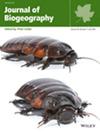Changes in Distribution Ranges of Abies Species Dominating in the Forests of Northeast Asia Since the Last Glacial Maximum
Abstract
Aim
Climate variations within the stadial–interstadial cycles drive shifts in the distribution of forest dominants. This study examines how climate dynamic alters the distribution ranges of two boreal and one cold-temperate Abies species dominating in Northeast Asia.
Location
Northeast Asia: China, Japan, Korea and Russia.
Taxon
Abies nephrolepis, A. sachalinensis (sect. Balsamea) and A. holophylla (sect. Pseudopicea).
Methods
We developed climate envelope species distribution models (SDMs) using warmth and coldness indices, the continentality index, and proxies of rain and snow precipitation indices. We interpolated SDMs on reconstructed climates for the Last Glacial Maximum (LGM) and the Holocene Climatic Optimum (HCO) and to predicted climates for 2070 under global warming scenarios RCP2.6 and RCP8.5.
Results
During the LGM, the climatic optimum for all species covered extensive areas on the shelves of the Japanese and Yellow Seas, facilitated by the global sea level drop. The interglacial climatic optimum supports the expansion of A. nephrolepis and A. sachalinensis compared to the LGM, whereas the range of A. holophylla climatic niche range experiences a reduction.
Main Conclusions
Our findings highlight the significant impact of climatic oscillations on the spatial distribution and ecological dynamics of Abies species in Northeast Asia. The contrasting responses of boreal and temperate fir species to glacial and interglacial periods underscore the complex interplay between climate change and the distribution of forest dominants. Projections under future warming scenarios suggest that Abies species will face further range shifts, emphasising the need for adaptive forest management and conservation strategies, especially in the southern part of their distribution.

 求助内容:
求助内容: 应助结果提醒方式:
应助结果提醒方式:


